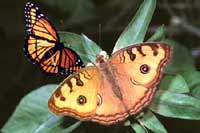
Dimdima
Online Children's Magazine from India

Dimdima
Online Children's Magazine from India



By Rani Iyer

Dependant on wild plants for food, and open countryside the butterflies are vulnerable to changes in the environment. In recent years, humans have caused harm to the butterflies. Destruction of rainforests for plantations, agriculture, roads, dams and other projects has meant that more butterflies are now classified as endangered species. Human activities such as spraying of insecticides, and herbicides harm the butterflies.
Beginning in 1776 when Moses Harris published his classical work, The Aurelian, butterflies have become collectable items. Species such as Jamaican large Swallowtail butterfly, Queen Alexandra's birdwing, and Philipine Swallowtail butterflies are very popular with the collectors. All these species are now declared endangered.
Not all collectors collect for vanity. Dedicated collectors since the eighteenth century have added to the large collections in The Musem Nationale d'Histoire Naturelle, Paris; The Smithsonian, Washington, D. C.; The Natural History Museum, London. Because of these earlier works, we are able to identify some of the extinct species today.
World over, butterflies are casualties of development and disturbance. Large copper butterfly, Black-veined White butterfly, Californian Xeres Blue, and Zebra swallowtail have not been spotted for several decades now. Butterflies like blue Morpho, are collected for making Morpho wing pendants. Only male butterflies are captured, as they are brighter than the female butterflies and slower in flight.
Reintroduction of species that have not been observed in some areas for a while has been attempted in Europe and North America. The Large Blue butterfly, Regal Fritillary butterfly, and sub species of Large copper butterfly have been re-introduced. In tropics, such studies are difficult because of the large numbers of species.
Local residents can help conserve butterfly populations. They can aid by growing food plants. Adult butterflies lay eggs on the leaves of these plants and the caterpillar eats and grows on them. Providing places or spots for puddling could be one of the ways to provide water and salt to the butterflies. Protecting known food plants and plants with eggs can also help the population of butterflies. With care, dedication, and effort, we can try to preserve these beautiful creatures from becoming casualties of development.
Last updated on :12/27/2003
EXPLORE MORE...
COMMENT ON THIS ARTICLE
Wants to share something related to this article? Please use the form below.
Dimdima is the Sanskrit word for ‘drumbeat’. In olden days, victory in battle was heralded by the beat of drums or any important news to be conveyed to the people used to be accompanied with drumbeats.
Bharatiya Vidya Bhavan
K. M Munshi Marg,
Chowpatty, Mumbai - 400 007
email : editor@dimdima.com
Bharatiya Vidya Bhavan
505, Sane Guruji Marg,
Tardeo, Mumbai - 400 034
email : promo@dimdima.com
Dimdima.com, the Children's Website of Bharatiya Vidya Bhavan launched in 2000 and came out with a Printed version of Dimdima Magazine in 2004. At present the Printed Version have more than 35,000 subscribers from India and Abroad.